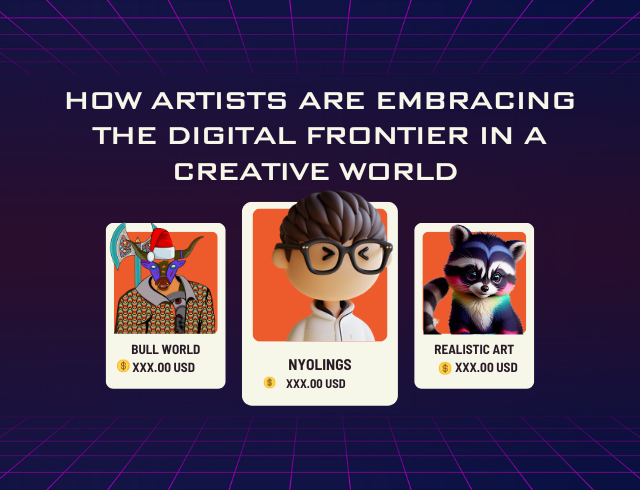![]()

Introduction
In the rapidly evolving landscape of the digital age, artists are finding new and innovative ways to express themselves. One of the most groundbreaking tools in their arsenal is cryptocurrency. The fusion of art and technology has given rise to a movement. Also, creators are pushing the boundaries of traditional artistic mediums and exploring the vast possibilities offered by blockchain and cryptocurrencies. This blog explores the intersection of cryptocurrency and creativity. And, delving into how artists navigate the digital frontier and redefine the art world.
The Rise of Cryptocurrencies in the Art World
Cryptocurrencies, particularly Bitcoin and Ethereum, have gained widespread recognition not just as alternative forms of currency but also as revolutionary tools for the art industry. The introduction of blockchain technology, which serves as a decentralized and transparent ledger. Also, has brought about significant changes in the way art is created, owned, and traded.
Smart Contracts and Tokenization
One of the key features of blockchain technology is the implementation of smart contracts. And self-executing contracts with the terms of the agreement directly written into code. Artists are leveraging smart contracts to automate various aspects of their work, from royalty distribution to ensuring the authenticity of digital assets.
Tokenization, the process of converting rights to an asset into a digital token on a blockchain, has enabled artists to fractionalize ownership of their work. This democratizes access to art, allowing a broader audience to invest in and own a stake in valuable pieces.
Crypto Art and Non-Fungible Tokens (NFTs)
The advent of Non-Fungible Tokens (NFTs) has been a game-changer for digital artists. NFTs are unique digital tokens that represent ownership or proof of authenticity of a specific item, often digital art. Artists can tokenize their work as NFTs, making them scarce and tradable on blockchain marketplaces. This has opened up new revenue streams for creators and challenged traditional notions of ownership and copyright.
Challenges and Criticisms
While the integration of cryptocurrency in the art world has brought about numerous opportunities, it has also faced criticism and challenges. Environmental concerns related to the energy consumption of blockchain networks, market volatility, and questions about the intrinsic value of digital art are among the issues that artists and the crypto community are actively addressing.
Case Studies
Several artists have gained international recognition for their pioneering work in the intersection of cryptocurrency and creativity. Beeple, the digital artist behind the record-breaking NFT sale at Christie’s auction house, and 3LAU, a musician who tokenized his music, are just a few examples of creators pushing the boundaries of traditional artistic mediums.
The Future of Cryptocurrency and Creativity
As blockchain technology matures and the adoption of cryptocurrencies becomes more widespread, the relationship between artists and the digital frontier will likely deepen. The possibilities are vast, from creating immersive virtual reality art experiences to entirely new economic models for compensating artists.
Conclusion
Cryptocurrency and creativity are converging in ways that are reshaping the art world. The use of blockchain technology, smart contracts, and NFTs is empowering artists to take control of their work, engage with a global audience, and explore new frontiers of expression. While challenges persist, the potential for innovation and disruption in the creative space is undeniable. As artists continue to embrace the digital frontier, the future promises a dynamic and transformative era for the intersection of cryptocurrency and creativity.
